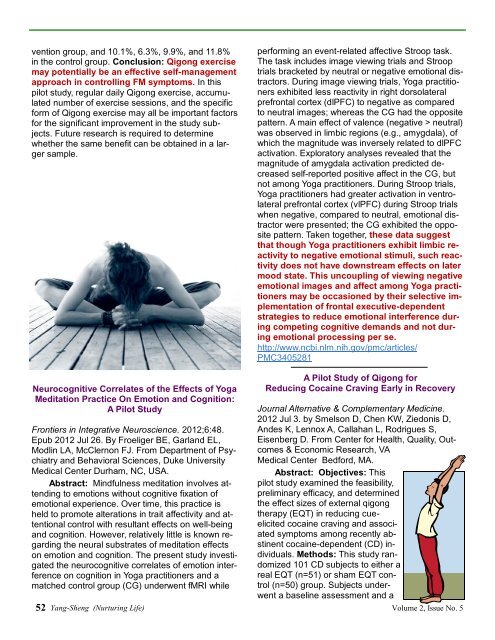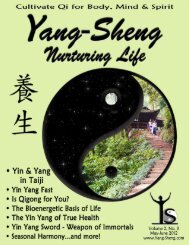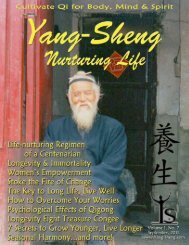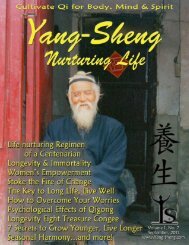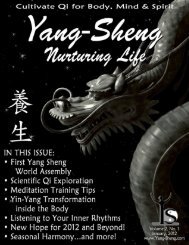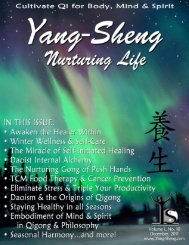Download - Yang-Sheng
Download - Yang-Sheng
Download - Yang-Sheng
Create successful ePaper yourself
Turn your PDF publications into a flip-book with our unique Google optimized e-Paper software.
vention group, and 10.1%, 6.3%, 9.9%, and 11.8%<br />
in the control group. Conclusion: Qigong exercise<br />
may potentially be an effective self-management<br />
approach in controlling FM symptoms. In this<br />
pilot study, regular daily Qigong exercise, accumulated<br />
number of exercise sessions, and the specific<br />
form of Qigong exercise may all be important factors<br />
for the significant improvement in the study subjects.<br />
Future research is required to determine<br />
whether the same benefit can be obtained in a larger<br />
sample.<br />
performing an event-related affective Stroop task.<br />
The task includes image viewing trials and Stroop<br />
trials bracketed by neutral or negative emotional distractors.<br />
During image viewing trials, Yoga practitioners<br />
exhibited less reactivity in right dorsolateral<br />
prefrontal cortex (dlPFC) to negative as compared<br />
to neutral images; whereas the CG had the opposite<br />
pattern. A main effect of valence (negative > neutral)<br />
was observed in limbic regions (e.g., amygdala), of<br />
which the magnitude was inversely related to dlPFC<br />
activation. Exploratory analyses revealed that the<br />
magnitude of amygdala activation predicted decreased<br />
self-reported positive affect in the CG, but<br />
not among Yoga practitioners. During Stroop trials,<br />
Yoga practitioners had greater activation in ventrolateral<br />
prefrontal cortex (vlPFC) during Stroop trials<br />
when negative, compared to neutral, emotional distractor<br />
were presented; the CG exhibited the opposite<br />
pattern. Taken together, these data suggest<br />
that though Yoga practitioners exhibit limbic reactivity<br />
to negative emotional stimuli, such reactivity<br />
does not have downstream effects on later<br />
mood state. This uncoupling of viewing negative<br />
emotional images and affect among Yoga practitioners<br />
may be occasioned by their selective implementation<br />
of frontal executive-dependent<br />
strategies to reduce emotional interference during<br />
competing cognitive demands and not during<br />
emotional processing per se.<br />
http://www.ncbi.nlm.nih.gov/pmc/articles/<br />
PMC3405281<br />
Neurocognitive Correlates of the Effects of Yoga<br />
Meditation Practice On Emotion and Cognition:<br />
A Pilot Study<br />
A Pilot Study of Qigong for<br />
Reducing Cocaine Craving Early in Recovery<br />
Journal Alternative & Complementary Medicine.<br />
2012 Jul 3. by Smelson D, Chen KW, Ziedonis D,<br />
Frontiers in Integrative Neuroscience. 2012;6:48. Andes K, Lennox A, Callahan L, Rodrigues S,<br />
Epub 2012 Jul 26. By Froeliger BE, Garland EL, Eisenberg D. From Center for Health, Quality, Outcomes<br />
Modlin LA, McClernon FJ. From Department of Psychiatry<br />
& Economic Research, VA<br />
and Behavioral Sciences, Duke University Medical Center Bedford, MA.<br />
Medical Center Durham, NC, USA.<br />
Abstract: Objectives: This<br />
Abstract: Mindfulness meditation involves attending<br />
pilot study examined the feasibility,<br />
to emotions without cognitive fixation of preliminary efficacy, and determined<br />
emotional experience. Over time, this practice is the effect sizes of external qigong<br />
held to promote alterations in trait affectivity and attentional<br />
therapy (EQT) in reducing cue-<br />
control with resultant effects on well-being elicited cocaine craving and associ-<br />
and cognition. However, relatively little is known regarding<br />
ated symptoms among recently ab-<br />
the neural substrates of meditation effects stinent cocaine-dependent (CD) inated<br />
on emotion and cognition. The present study investigated<br />
dividuals. Methods: This study ranference<br />
the neurocognitive correlates of emotion interdomized<br />
101 CD subjects to either a<br />
on cognition in Yoga practitioners and a real EQT (n=51) or sham EQT control<br />
matched control group (CG) underwent fMRI while<br />
(n=50) group. Subjects under-<br />
went a baseline assessment and a<br />
52 <strong>Yang</strong>-<strong>Sheng</strong> (Nurturing Life) Volume 2, Issue No. 5


